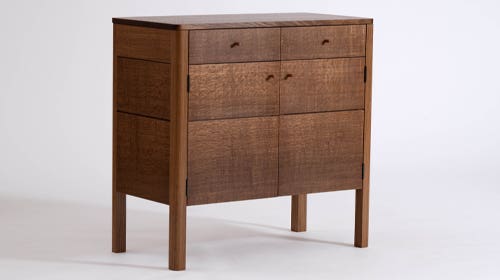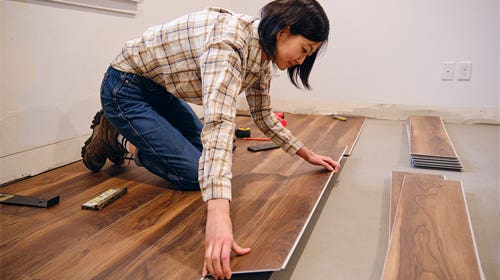Cocobolo lauded for looks but shorter supplies noted
Cocobolo is a true rosewood and one of the world’s most attractive exotic woods, exhibiting a wide range of rich colors including shades of orange, yellow, red and brown, accompanied…
Cocobolo is a true rosewood and one of the world’s most attractive exotic woods, exhibiting a wide range of rich colors including shades of orange, yellow, red and brown, accompanied by black striping. Cocobolo (Dalbergia retusa) grows mainly in the Pacific regions of Mexico and Central America to heights up to 60' with trunk diameters as large as 2' to 3'. As is the case with many exotic woods, cocobolo supplies are diminishing because of excessive logging.
“Right now, cocobolo, especially Mexican cocobolo, is in real short supply and in high demand,” says Mitch Talcove, owner of Tropical Exotic Hardwoods, a retail and wholesale supplier in Carlsbad, Calif. Talcove has operated a cocobolo mill in Mexico for nearly 30 years. “A lot of the suppliers down there that didn’t put the groundwork into getting permits are no longer supplying it. They’ve cracked down in Mexico. And at the last convention of CITES (Convention on International Trade in Endangered Species of Wild Fauna and Flora) they were able to place cocobolo that grows in Guatemala on Appendix III [thereby preventing trade of Guatemalan cocobolo].”
“There are six to eight different kinds of Dalbergia retusa, the bark looks different, the leaf looks different, when you cut it, it looks different, and as it grows higher in altitude, it gets darker in color,” says Rocky Mehta, owner of West Penn Hardwoods in Olean, N.Y. “After Dalbergia nigra [Brazilian rosewood], this is the best rosewood there is.”
Cocobolo is used for furniture, cutlery handles, musical instruments, jewelry boxes, and other novelty items. It is rarely used in cabinetry and is a difficult wood to slice into veneer.
“If you go to a craft show and a guy has pens, jewelry boxes, whatever, and he has 100 boxes made out of 100 different woods, it seems like cocobolo is always one of the most popular ones,” says Matt Westmoreland of World Timber Corp., a wholesaler in Hubert, N.C. “It has a striking beauty that is known everywhere. It’s great for the novelty stuff, very popular with the turners.”
“Widths aren’t too bad; we’re still getting stuff up to 8" to 9" wide, lengths always shorter than 6',” says Myles Gilmer of Gilmer Wood Co., a retail and wholesale specialty wood dealer in Portland, Ore. “I still have some really big cants from both Mexico and Panama, but most of it gets chopped up into pretty small pieces. It’s the perfect wood for handles, and pistol stocks, all the small stuff — jewelry boxes, duck calls, precious little things.”
Cocobolo is heavy and durable. The specific gravity varies depending on the growth area, but it generally ranges between .85 and .95. It has a bit of an oily substance and is very resinous. Cocobolo is not an easy wood to dry and is prone to crack, check or warp if not air-dried before kiln drying.
“The Mexican cocobolo always seems to be the craft maker’s favorite,” Westmoreland says. “It’s much more orange with some wild grain pattern, while the Nicaraguan tends to be much darker; more of a true rosewood, kind of a muddy color. You don’t get as much brilliant color as the Mexican.”
Cocobolo’s working properties are a mixed bag. It machines fairly well, takes a fine finish, but on the negative side, it glues poorly because of its oily, waxy surface. Its dust is an irritant to many woodworkers, sometimes causing dermatitis or producing a rash.
“The stuff from Panama is lighter in color and more of a yellowish-orange color whereas Mexican has more reds in it,” adds Gilmer. “It has a different oil or chemical in it that just lights me up. I can cut Mexican all day long and the dust doesn’t bother me, but the Panamanian stuff — one whiff and I have like an asthma-type reaction to it. I have to mask up and really be careful. When I finish, I immediately take a shower to get everything off me.”
“I’m selling a lot for musical instruments at the moment,” Talcove says. “They’re starting to make clarinets out of it instead of blackwood because it is hard to get. The specific gravity is very close to African blackwood … people are even buying cocobolo for bagpipes and dying it black.”
The grain varies from straight to wavy and much of the lumber exhibits figure. Some highly figured boards are absolutely gorgeous in appearance and are priced accordingly.
“Even though the price has gone up in the last five years, it’s still a reasonably priced wood considering the quality of the wood,” notes Gilmer. “If you’re getting defect-free stuff, then it is gorgeous, just a fantastic wood. I’m surprised it hasn’t gone the way (price-wise) as koa, for example.”
Cocobolo is one of the exotic woods where the cost is wide-ranging, determined by the amount of figure and the considerable markup by some dealers. In lumber form, 4/4 cocobolo with little or no figure retails from $13.65 to $19.50/bf; $14 to $24/bf for 8/4; and around $30/bf for 12/4. Boards with higher amounts of figure run as high as $50/bf.
Mildly figured turning squares measuring 1-1/2" x 1-1/2" x 12" sell from $6.50 to $11 each, pool cue blanks are priced from $7 to $18 apiece. The wood is also available in bowl blanks, pen blanks, 3"-plus billets, and one dealer quoted log pricing from $2.50 to $4/lb.
This article originally appeared in the January 2009 issue.







